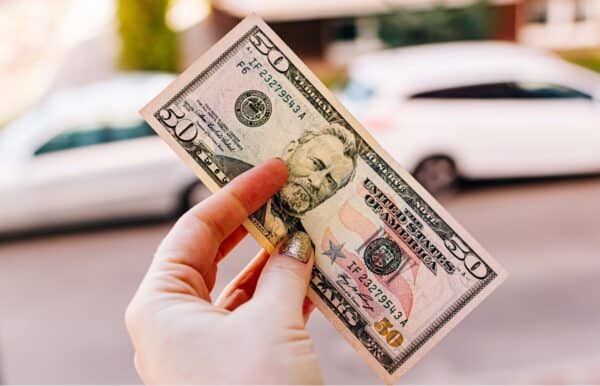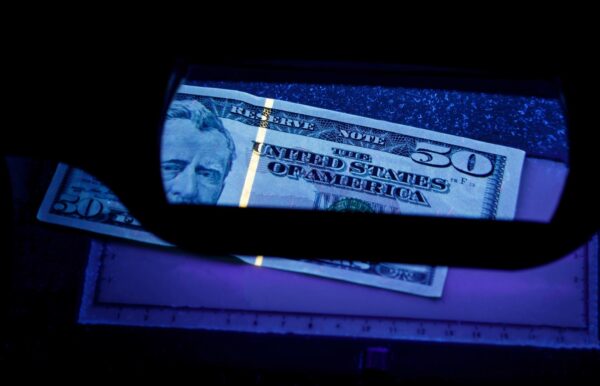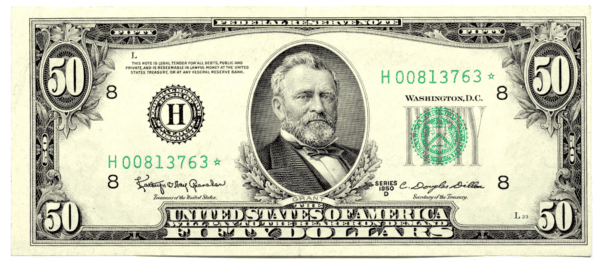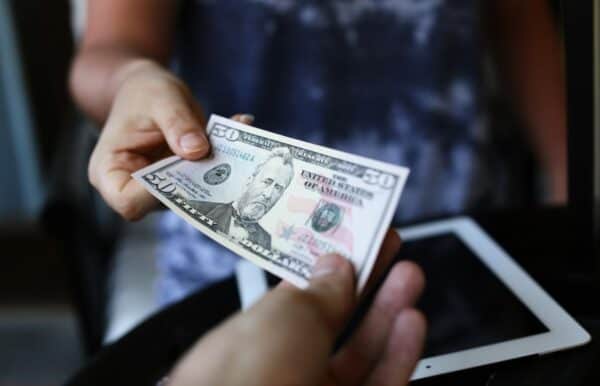Discover the fascinating story behind 1950 $50 bills and how they reflect America’s booming economy.
Learn how to spot counterfeit bills among the originals by examining serial numbers, security threads, and color-shifting ink. Dive deeper into this intriguing topic by reading the full article for valuable insights and tips.

Key Takeaway
- The 1950 $50 bill features Ulysses S. Grant on the front and an image of the U.S. Capitol on the back, reflecting America’s prosperous post-war economy.
- These vintage bills can have value to currency collectors and enthusiasts if they are in good, uncirculated condition.
- Authentic 1950s $50s can be verified through security features like serial numbers, security threads, and detailed portraits, while counterfeits may lack these.
- If you come across a counterfeit 1950s bill, you should not try to use it but rather turn it over to authorities to avoid legal consequences.
Overview of 1950 $50 Bills and Counterfeits
During the 1950s, the United States underwent big economic and social changes.
These changes were reflected in various aspects of American life, such as clothing, hairstyles, music, movies, art, and industry.
The most important thing, which was the country’s economy thrived during this period . And the U.S. gained its place as a global economic leader. So, the $50 bill played an important role in the growing U.S. economy, as it was widely circulating with other Federal Reserve notes.
The front of the $50 note from the 1950s features Ulysses S. Grant, the 18th President of the United States. The back of the note depicts the United States Capitol.
Like other Federal Reserve bank notes, this one was made of cotton and linen fibers. The color scheme featured shades of green and black, which was common during this era.
Over the years, the $50 note has undergone numerous redesigns since adding new security features and updating its visual appearance was important. Changes were made to the portraits, currency background, and security elements to enhance its overall safety and aesthetics.
Today, some collectors might be interested in getting vintage U.S. currency, including the 1950s 50-dollar bill. The value of a 50-dollar bill may vary depending on its condition, rarity, and demand among collectors. So consequently, counterfeit money can be present.
Is it possible to get a fake denomination? The answer is hidden in plain sight below.

According to the United States Department of Treasury, there is an estimated $70 million worth of counterfeit bills in circulation in the United States. That means there is around one counterfeit bill for every 10,000 genuine notes.
It is rare to find a counterfeit 1950s $50 bill – as it is old and rare – usually held by collectors or withdrawn from currency exchange.
However, if you come across one, I’m here to help you confidently tell the difference between an original and a fake banknote.
3 Ways to Tell Authenticity: Is Your $50 Real or Fake?
If you’re a little bit curious about how to tell if your bill is fake or a real one, I’ve got you covered. Here are the three most common warning signs you should watch out for to grasp the bill’s authenticity.
1. Examine the Serial Numbers
When authenticating a bill, the serial number is typically the first point of verification. You’ll find two serial numbers on the front of the note, known as the obverse.
One is situated in the top-right corner, usually near or just below the portrait of Ulysses S. Grant, while the other resides in the bottom-left corner, adjacent to the border or edge of the bill.
These serial numbers adhere to specific design features, they’re printed with consistent spacing between letters and digits, horizontally aligned, and parallel to the bill’s edges.
Additionally, the font size is sizable, which ensures clear visibility and legibility.
For currency collectors, a noteworthy term is “low-number bills.” These banknotes feature serial numbers that initiate with zeroes or contain small numerical values at the beginning of the sequence, enhancing their desirability and value among enthusiasts.
But let’s not stop there – there’s something else I’d like to draw your attention to.
It’s essential to inspect both sides of the bill thoroughly
On the reverse side, also known as the back of the bill, you’ll find various design elements characteristic of United States currency. The Department of the Treasury oversees the production and design of United States notes, ensuring consistency and security features.
Moreover, the left serial number identifies the bill’s position within the printing process, providing insight into its production. Colors such as blue and red are commonly utilized in the design of US currency, contributing to its distinctive appearance and aiding in counterfeit detection.
2. Check for the Security Thread
The security thread stands as a hallmark feature of modern US dollar bills. This ensures the authenticity and deterring counterfeiting attempts.
Just for reference, this thin, embedded thread runs vertically from top to bottom within the banknote.
In contemporary bills, the security thread reacts to ultraviolet light, emitting a yellow glow that clearly indicates the currency’s legitimacy.
Even in the 1950s, the $50 bill incorporated a security thread positioned either to the left or center of the bill. Running vertically, it played a crucial role in verifying authenticity. When held to light, the security thread may be visible from both sides of the note, which automatically offers a straightforward method of validation.
Additionally, on the 1950s $50 bill, features such as the red seal and a small flag represent the Bureau of Engraving and Printing, symbolizing the authority and integrity behind US currency production. These elements serve as further deterrents to counterfeiting and reinforce the bill’s authenticity.
Ultimately, the security thread represents the entire Federal Reserve, underscoring the trust and confidence in US currency by citizens and institutions alike.
3. Verify Color-Shifting Ink

Over the years, advancements in security features on currency bills have continuously enhanced their authenticity and deterrence against counterfeiting.
One notable addition introduced in the 1990s is color-shifting ink, serving as an additional layer of security. This ink is applied to numerals and exhibits a color change from copper to green when the bill is tilted.
Typically situated in the lower right corner of the front of the bill, this feature offers a simple yet effective method for verification. However, it’s important to note that older $50 bills, such as those dating back to the 1950s, do not incorporate this feature. Nevertheless, modern dollar bills utilize color-shifting ink, providing a reliable means for authentication.
When examining a bill, take note of the Treasury seal and the depiction of the United States Capitol building.
These elements are integral components of United States currency and should exhibit precise detailing and clarity.
Furthermore, there’s typically space to the right of the Treasury seal, allowing room for additional security features and design elements. Additionally, running your fingers over the bill enables you to feel the raised printing, further confirming its authenticity.
Colors such as blue and red are prominently featured in the design of US currency, contributing to its recognizable appearance and aiding in counterfeit detection. These vibrant hues are strategically incorporated into various elements of the bill, enhancing both aesthetics and security.
Pro Tip: Find the Watermark
Over time, security features on currency bills have evolved.
One notable addition, introduced in the 1990s, is color-shifting ink. This ink, applied to numerals, undergoes a color change from copper to green when the bill is tilted. Typically found in the lower right corner on the front of the bill, this feature offers a straightforward yet effective method for verification.
It’s worth noting that older $50 bills, like those from the 1950s, lack this feature. However, modern dollar bills incorporate color-shifting ink. When scrutinizing a bill, pay attention to the Treasury seal and the depiction of the United States Capitol building, both crucial components of US currency. These elements should display precise detailing and clarity, aiding in authenticity verification.
Moreover, there’s usually space to the right of the Treasury seal, accommodating additional security features and design elements. Running your fingers over the bill allows you to feel the raised printing, further confirming its authenticity.
Colors such as blue and red play significant roles in the design of US currency, contributing to its distinct appearance and assisting in counterfeit detection. These vibrant hues are strategically integrated into various bill elements, enhancing both aesthetics and security.
Beneath the left serial number, you’ll find the United States flag depicted, another emblematic symbol of the nation.
A small metallic silver-blue star, unique to modern bills, is positioned within the flag’s design. President Grant’s portrait on the front of the bill remains consistent, though periodic design changes occur.
Notably, the blue star is located within the flag’s field of stars, adding to the bill’s overall complexity and security features.
Additional Ways to Spot Fakes
Apart from standard security features, there are various ways to identify the authenticity of a banknote.
- You can compare the portraits on the banknote with a genuine banknote or an image. Counterfeit notes usually have low-quality portraits and fewer details than genuine ones.
- The printing quality is also crucial. A genuine note has sharp and precise printing with clear details. If the printing is blurry, especially around images and security features, it could indicate a fake note.
- Genuine notes are printed on special textured paper, which provides a unique feel and thickness. You can run your fingers over the note to feel the texture. Fake notes often feel smooth compared to genuine ones.
- You can also use counterfeit detector pens, which easily detect fake notes. To check if a note is genuine, draw on it with a pen. If the note is authentic, the pen ink will remain colorless or yellow. But if the note is counterfeit, the ink in the pen will react differently, usually turning dark brown or black.
- Lastly, you can examine the banknote under UV light. Genuine notes have UV-reactive materials, threads, watermarks, and other visible features under UV light. It might be fake if a banknote lacks UV-reactive elements or shows strange fluorescence.
What Genuine 1950 $50 Bills Are Worth

The condition of old banknotes plays a crucial role in determining their value.
For instance, banknotes that are pristine, with no folds, creases, or discoloration, and those with clear portraits and texture are worth more.
Additionally, the rarer banknotes are usually more expensive – the public demand for a particular series can influence the value.
If you’re curious about how much your 1950s $50 bill is worth, consult some currency experts, collectors, or reputable dealers. They can give you insights into the rarity, condition, and current market demand for vintage currency. For instance, if you’re curious about how much is a 1950 $7 bill worth, a reputable dealer can provide an accurate appraisal based on their expertise. This knowledge helps you determine the banknote’s true value..
Remember to check out some online auction platforms and currency marketplaces for additional information on the current market value of your bill.
What to Do If You Have a Counterfeit
If you come across counterfeit money, it’s crucial not to utilize it. Circulating fake bills is illegal and carries severe consequences.
Using counterfeit bills constitutes fraud and can lead to criminal charges. Depending on the jurisdiction and the gravity of the offense, penalties may include fines, probation, community service, or imprisonment.
Upon receiving counterfeit bills, handle them with care to preserve evidence. Store the bill in an envelope or plastic bag to prevent further contamination.
If you acquired the counterfeit bill during a transaction, remember the details of where and when it was received. This information could be pivotal in identifying the source, whether an individual or a business.
Counterfeit bills hold no value, and you won’t be compensated for them. However, you can exchange them for genuine currency at a bank or legitimate financial institution.
Report the incident promptly to your local police station or the U.S. Secret Service. Provide as much information as possible to aid their investigation.
Ensure your awareness of security features like the security thread and microprinting, crucial elements of authentic bills. These features, along with the Federal Reserve Bank seal and the vignette of the United States, help distinguish genuine currency.
Additionally, letters and numbers beneath the Federal Reserve Bank seal aid those with visual impairments in identifying the denomination. The three red stripes, strategically placed, are another distinctive feature, serving as further authentication against counterfeiting.
